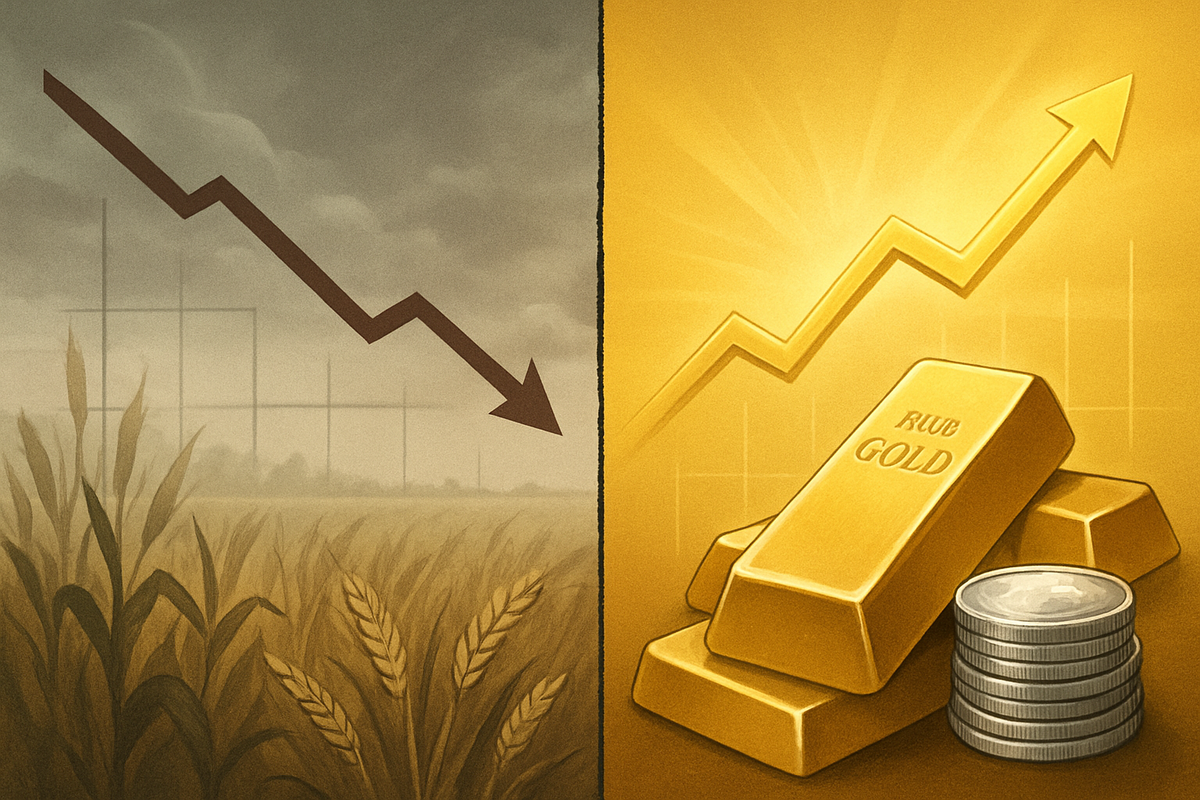
Teucrium's Q3 2025 report has sent ripples through the commodity futures market, revealing significant losses in its agricultural commodity funds and a discernible pivot towards precious metals. This strategic shift by a prominent issuer of commodity-focused exchange-traded funds (ETFs) signals a crucial re-evaluation of investor sentiment, reflecting deep-seated concerns about the agricultural sector's near-term prospects and a bolstered confidence in traditional safe-haven assets amidst persistent global uncertainties. The report's findings suggest a challenging environment for agricultural producers and a potentially lucrative period for precious metals companies, compelling market participants to reassess their hedging strategies and portfolio allocations.
The immediate implications are clear: a cautious approach to agricultural futures is warranted, while the allure of precious metals as a hedge against inflation and geopolitical instability continues to grow. This divergence in sentiment, highlighted by Teucrium's performance, underscores a broader narrative of capital rotation, where investors are increasingly seeking stability and value preservation in a volatile economic landscape.
Teucrium's Q3 2025 Report: A Deep Dive into Divergent Fortunes
For the three months ending September 30, 2025, Teucrium Commodity Trust (NYSEARCA: TAGS) reported substantial financial losses, with a total income loss of $(9,162,349) and a net income loss of $(10,850,151). These figures, disclosed in its SEC 10-Q filing on November 10, 2025, were primarily driven by unfavorable trading activities in agricultural commodity futures contracts. The underlying markets tracked by funds such as the Teucrium Corn Fund (NYSEARCA: CORN), Teucrium Sugar Fund (NYSEARCA: CANE), Teucrium Soybean Fund (NYSEARCA: SOYB), and Teucrium Wheat Fund (NYSEARCA: WEAT) faced significant depreciation or adverse market conditions during the quarter. Further underscoring the severity of the situation, Teucrium Trading LLC, the sponsor of the Trust, announced a one-for-five reverse share split for its Teucrium Wheat Fund (WEAT), effective November 25, 2025—a move often indicative of sustained underperformance.
The timeline leading up to this revelation saw Q3 2025 characterized by broad depreciation in agricultural commodity futures. This period was marked by factors such as anticipated bumper harvests, improved weather conditions, and weakening global demand, all contributing to increased speculative net short positions in commodities like wheat, corn, and soybeans. Conversely, the same quarter witnessed significant rallies in precious metals, with gold and silver recording substantial gains driven by robust global demand, supply disruptions, and a perceived dovish shift by the Federal Reserve. The energy sector, however, remained relatively flat.
Key players in this unfolding scenario include Teucrium Commodity Trust and its sponsor, Teucrium Trading LLC, along with the investors holding shares in their various agricultural commodity ETFs. The initial market reaction to Teucrium's losses and the WEAT reverse split is expected to be a decline in investor confidence in single-commodity agricultural ETFs, potentially leading to a reallocation of capital towards broader commodity indices or other asset classes. This also reinforces a bearish sentiment in short-term wheat futures trading and highlights the broader macroeconomic and geopolitical headwinds impacting commodity prices, including supply chain risks, climate challenges, and monetary policy stances.
Winners and Losers: Corporate Impacts of Commodity Shifts
The clear divergence in commodity market sentiment, as highlighted by Teucrium's Q3 2025 report, will inevitably create a distinct set of winners and losers among public companies. The bearish outlook for agricultural commodities implies lower prices, generally benefiting net consumers while negatively impacting producers and input suppliers. Conversely, the bullish sentiment for precious metals will directly benefit mining and streaming companies in that sector.
Potential Losers in Agricultural Markets:
Companies involved in agricultural production, input supply, and equipment manufacturing are likely to face headwinds.
- Agricultural Equipment Manufacturers: Firms like Deere & Company (NYSE: DE) and AGCO Corporation (NYSE: AGCO) could see reduced demand for machinery as farmers' incomes decline, leading to delayed capital expenditures.
- Fertilizer and Crop Protection Companies: Lower farmer profitability may lead to reduced application rates for fertilizers and pesticides, impacting sales for companies such as Nutrien Ltd. (NYSE: NTR), Corteva, Inc. (NYSE: CTVA), Bayer AG (XETRA: BAYN), and The Mosaic Company (NYSE: MOS).
- Agricultural Producers: Direct producers of commodities like corn, wheat, soybeans, and sugar will see revenues decline. Examples include Cresud S.A. (NASDAQ: CRESY), Adecoagro S.A. (NYSE: AGRO), and Cosan S.A. (NYSE: CSAN), which have significant exposure to these markets.
Potential Winners in Agricultural Markets:
Conversely, companies that are net consumers or processors of agricultural commodities stand to benefit from lower input costs.
- Food Processing and Consumer Goods Companies: Giants like Archer-Daniels-Midland Company (NYSE: ADM) and Bunge Global SA (NYSE: BG) could see improved margins in their processing segments. Major food and beverage companies such as Tyson Foods, Inc. (NYSE: TSN), Pilgrim's Pride Corporation (NASDAQ: PPC), General Mills, Inc. (NYSE: GIS), Post Holdings (NASDAQ: POST), The Kraft Heinz Company (NASDAQ: KHC), Mondelez International Inc. (NASDAQ: MDLZ), The Hershey Company (NYSE: HSY), Nestlé S.A. (OTC: NSRGY), The Coca-Cola Company (NYSE: KO), and PepsiCo, Inc. (NASDAQ: PEP) will benefit from reduced raw material costs for ingredients like corn, soybeans, wheat, and sugar. Restaurant chains like McDonald's Corporation (NYSE: MCD) and Chipotle Mexican Grill Inc. (NYSE: CMG) could also see lower food costs.
Potential Winners in Precious Metals Markets:
The shift towards precious metals creates a favorable environment for mining and streaming companies in the gold and silver sectors.
- Gold Mining Companies: Higher gold prices will directly boost revenues and margins for major gold miners such as Newmont Corporation (NYSE: NEM), Barrick Gold Corporation (NYSE: GOLD), Agnico Eagle Mines Limited (NYSE: AEM), Kinross Gold Corporation (NYSE: KGC), and AngloGold Ashanti PLC (NYSE: AU).
- Silver Mining Companies: Similarly, silver miners like Pan American Silver Corp. (NASDAQ: PAAS), Hecla Mining Company (NYSE: HL), First Majestic Silver Corp. (NYSE: AG), Coeur Mining, Inc. (NYSE: CDE), and MAG Silver Corp. (NYSE: MAG) will benefit from increased demand and higher silver prices.
- Precious Metals Streaming/Royalty Companies: Companies like Wheaton Precious Metals Corp. (NYSE: WPM) and Royal Gold Inc. (NASDAQ: RGLD), which provide upfront capital in exchange for future production at fixed costs, are well-positioned to profit from rising gold and silver prices with less operational risk.
Wider Significance: Echoes of Broader Market Trends
Teucrium's Q3 2025 report, revealing agricultural commodity losses and a pivot to precious metals, is more than an isolated event; it's a potential bellwether for broader industry trends shaping the global commodity landscape. This strategic reallocation by a specialized ETF provider signals a significant re-evaluation of risk and return in the face of ongoing macroeconomic and geopolitical instabilities.
This event aligns with several anticipated trends for 2025. Firstly, agricultural markets have been facing headwinds from factors such as record crop outputs in some regions, weaker global demand (particularly from key importers), and rising input costs. Forecasts from institutions like the World Bank have projected declines in agricultural commodity prices for 2025, making Teucrium's reported losses consistent with a challenging environment for the sector. Geopolitical tensions, trade disputes, and the escalating impacts of climate change further contribute to supply chain disruptions and price volatility in agriculture.
Secondly, the flight to safety and the rally in precious metals, particularly gold and silver, is a well-established trend. Driven by persistent global economic uncertainties, inflation concerns, and expectations of potential dovish shifts in monetary policy, gold is increasingly sought as a hedge against inflation and a safe-haven asset. Central banks globally have been consistently increasing their gold reserves, reinforcing this trend. Silver also benefits from this safe-haven demand, alongside growing industrial demand in emerging technologies like solar panels.
The ripple effects extend to competitors and partners. Other ETF providers specializing in agricultural commodities may face similar pressures, potentially leading to diversification of offerings or a struggle to attract investors. Futures exchanges, such as the CME Group (NASDAQ: CME), would likely see a shift in trading volumes from agricultural contracts to precious metal contracts, impacting their revenue streams. Regulatory bodies like the CFTC will closely monitor such significant shifts in investment strategy by regulated entities, ensuring investor protection and market stability. Historically, periods of high inflation (like the 1970s) or global financial crises (like 2008) have seen similar capital movements towards tangible assets and safe havens, underscoring the cyclical nature of commodity market sentiment. This current shift could be viewed as another phase in the long-term commodity cycle, where macroeconomic stressors favor precious metals over more growth-sensitive agricultural assets.
What Comes Next: Navigating a Divergent Commodity Landscape
Following Teucrium's Q3 2025 report, the commodity futures market is set to navigate a period of pronounced divergence, with distinct short-term and long-term possibilities for different commodity classes. Market participants will need to adapt strategically to emerging opportunities and challenges.
In the short term (Q4 2025 - Mid-2026), agricultural commodity futures are likely to remain under pressure. Weakening global demand, particularly from emerging markets, coupled with high input costs for farmers, will continue to squeeze profitability and suppress prices. Discretionary agricultural products may face reduced consumer demand during economic slowdowns. Conversely, precious metals are expected to maintain strong upward momentum. Gold prices, already having seen significant gains in 2025, are projected to reach $3,800-$4,000 per ounce by late 2025, driven by economic uncertainty, geopolitical tensions, and anticipated interest rate cuts. Silver and platinum are also poised for gains, with silver potentially targeting $50 per ounce, benefiting from both safe-haven demand and growing industrial applications. Overall market volatility is expected to remain high across both sectors.
Looking to the long term (Late 2026 and Beyond), the agricultural market is projected for overall growth, albeit with significant challenges. A compound annual growth rate (CAGR) of 3.2% by 2032 is anticipated, but this growth will be shaped by increasing climate unpredictability and the need for technological advancements in farming to mitigate risks. Demand for essential food items will provide a stable base. Precious metals, however, are expected to exhibit enduring strength. Gold is widely projected to approach or surpass $5,000 per ounce by late 2026 or 2030, supported by deglobalization trends, persistent inflation, energy transition costs, and continued central bank diversification. The global precious metals market is forecast to reach $865.3 billion by 2030, growing at a CAGR of 9.1% from 2025, fueled by both investment and industrial demand.
Strategic pivots for market participants are crucial. Investors should prioritize enhanced diversification, not just within commodities but across broader asset classes, to mitigate risks. Sophisticated hedging strategies, including futures, options, and swaps, will be essential for agricultural producers and consumers to manage price volatility and input costs. Precious metals investors may use futures to capitalize on price appreciation or options for flexible risk management. Continuous, vigilant monitoring of global economic indicators, geopolitical developments, and supply chain dynamics will be paramount. Agricultural producers must also focus on cost efficiency and resilient farming practices to counteract high input costs and climate impacts.
Emerging opportunities include the growing industrial demand for silver and platinum in green technologies, robust central bank gold purchases, and the potential for innovative commodity-linked ETFs. Challenges for agricultural markets include sustained supply chain vulnerabilities due to geopolitical tensions and climate change, trade barriers, and food security concerns in importing nations.
Potential scenarios include a "Safe Haven Dominance" where precious metals thrive amidst persistent uncertainty, while agricultural commodities struggle. An "Inflationary Rebound with Sectoral Divergence" could see precious metals continue their bullish trend, with agricultural commodities experiencing a modest rebound but constrained by high input costs. A "Global Recovery and Rebalancing" scenario, though less likely in the short term, would involve a resolution of geopolitical tensions and strong economic growth, leading to a rebalancing of commodity markets.
Wrap-up: A New Era for Commodity Investment
Teucrium's Q3 2025 report serves as a pivotal marker, underscoring a significant shift in investor sentiment within the commodity markets. The stark contrast between substantial losses in agricultural commodity futures and a strategic pivot towards precious metals highlights a re-evaluation of risk and opportunity that will likely define investment strategies in the coming months and years.
Key Takeaways from the report are clear: the agricultural sector faces a challenging environment, characterized by potential oversupply, weakened demand, and high input costs, leading to compressed margins for producers. Conversely, precious metals are firmly entrenched as a preferred asset class, benefiting from their traditional roles as safe havens and inflation hedges, further bolstered by ongoing global economic and geopolitical uncertainties. This bifurcation suggests a deeper structural shift rather than a fleeting market anomaly.
Moving forward, the market is poised for continued divergence. Agricultural commodity prices are likely to remain under pressure or see only modest gains, with profitability for farmers and related industries remaining tight. The Teucrium Wheat Fund's (WEAT) reverse share split is a tangible indicator of this challenging outlook. Precious metals, however, are expected to maintain their bullish trajectory, driven by macroeconomic factors like inflation, anticipated interest rate adjustments, and sustained central bank demand.
The significance and lasting impact of Teucrium's strategic reallocation cannot be overstated. As a specialized provider of agricultural commodity ETFs, their move could act as a bellwether, prompting other institutional investors to reassess their own allocations. This could lead to a broader market rebalancing, reinforcing the role of precious metals as a core portfolio diversifier during periods of economic uncertainty and fostering a more cautious, targeted approach to agricultural commodity investments, focusing more on niche opportunities or specific supply-demand imbalances rather than broad market exposure. The event also underscores the increasing interconnectedness of global markets and the profound influence of macroeconomic and geopolitical factors on commodity pricing.
Investors should watch for several key indicators in the coming months. In the agricultural sector, monitor global harvest reports, evolving weather patterns (including potential La Niña events), and any shifts in trade policies or export restrictions. Keep a close eye on energy and fertilizer costs, as these directly impact agricultural profitability. For precious metals, track inflation data, central bank statements on monetary policy, and major geopolitical developments. A sustained weaker U.S. dollar and continued robust central bank gold purchases would signal further strength. Finally, broader global economic growth forecasts—particularly signs of recession or heightened volatility—will continue to reinforce the safe-haven appeal of precious metals, while a strong, stable recovery could eventually lead to a rebalancing towards growth-sensitive commodities, though agricultural fundamentals would still need significant improvement.
This content is intended for informational purposes only and is not financial advice





